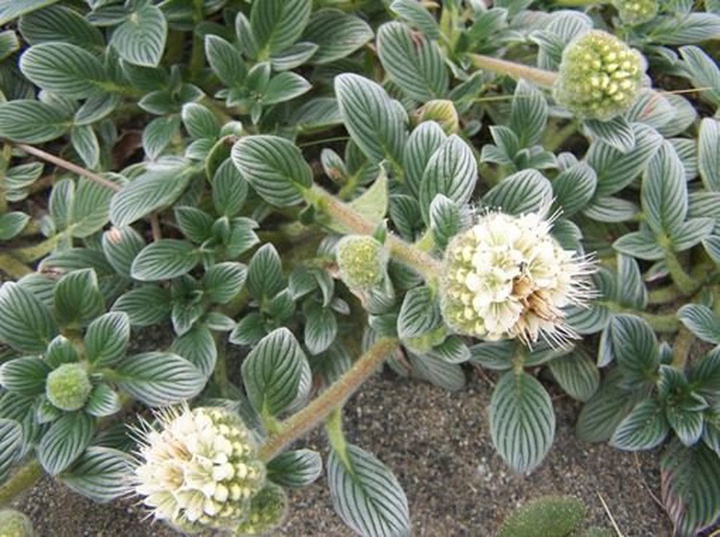Jessica Cejnar Andrews / Thursday, Aug. 31, 2023 @ 5:03 p.m.
Rare Plant Endemic to Del Norte's Sand Dunes Gets Federal Protection

While found in Del Norte, Curry and Coos counties, the silvery phacelia's stronghold is in the Tolowa Dunes. | Photo courtesy of Sandra Jerabek
A flowering perennial in the forget-me-not family whose remaining stronghold is in Del Norte County’s coastal dunes has gained federal protection under the Endangered Species Act.
The sand dune phacelia’s final listing as threatened is good news for the Tolowa Dunes Stewards, which is celebrating its 20th anniversary, Director Sandra Jerabek told the Wild Rivers Outpost.
Jerabek and a group of 15-20 of volunteers have spent the past two decades removing European beach grass in both the Lake Earl Wildlife Area and Tolowa Dunes State Park. In a 30-acre spot on the wildlife area, the invasive grass crowded out all but eight individual phacelia plants, she said. Now, more than 600 are thriving.
“It loves it out there,” Jerabek said of the sand dune phacelia. “Removal of beach grass works. And restoring these precious dune ecosystems, it’s very gratifying to watch what happens spring-to-spring, year-to-year.”
The sand dune phacelia, also called the silvery phacelia, is endemic to Southern Oregon and Northern California, ranging from Crescent City to Bandon. Its habitat quality is often poor and encroachment from European beachgrass and gorse threatens remaining populations.
As part of the listing, the U.S. Fish and Wildlife Service is designating 181 acres of critical habitat to protect the silvery phacelia. In Del Norte County, that critical habitat is at Pacific Shores, Tolowa Dunes, Point St. George and Pebble Beach.
In Oregon, the critical habitat set aside to protect the sand dune phacelia include areas near Bandon, Lost Lake and Floras Lake,Cape Blanco, Paradise Point, Pistol River and Lone Ranch.
“Our restoration area is the only place where it’s really doing well on public lands,” Jerabek said. “It’s found at various locations up and down the coast, so it is still found in these other locations in Oregon, but we are the only one where it’s doing well on public lands.”
Jerabek noted that one of the critical habitat areas is at the Bandon Golf Course.
The silvery phacelia’s listing comes at a time when the Tolowa Dunes Stewards is working under a $1.7 million California Wildlife Conservation Board grant to do restoration work in a marshy area of Lake Tolowa, the body of water separating the coastal lagoon of Lake Earl from the ocean.
Jerabek said the organization has roughly three years to complete the work, removing beach grass by hand and using heavy equipment like excavators and bulldozers. In addition to working with her longtime volunteers, who have brought silvery phacelia and about 92 other native plants back to the dunes, Jerabek and the Tolowa Dunes Stewards host about 300 youth from the Sierra Service Project.
“We have permits to use an excavator and a bulldozer to dig a deep trench and then to put the beachgrass into the trench and bury it,” she said. “But people might be surprised to know that you have to keep going back in there and manually remove the re-sprouts. This stuff will re-sprout forever.”
Manual removal of European beachgrass keeps the seedbed of native plants intact, Jerabek said. Between the Tolowa Dunes Stewards volunteers and California State Park staff, sand dune phacelia plants and other native plants have re-established themselves on 50 acres of land, she said.
“The volunteers are thrilled that their work is paying off,” Jerabek said.
The proposed listing of the silvery phacelia as threatened comes after the Center for Biological Diversitythe Environmental Protection Information Center (EPIC) filed a lawsuit in 2020. That lawsuit sought to force the U.S. Fish and Wildlife Service to make timely evaluations and protection decision for 241 plant and animal species, including the silvery phacelia.
The Center for Biological Diversity filed its lawsuit after it and seven other conservation groups, including Friends of Del Norte, the California Native Plant Society and the Environmental Protection Information Center submitted a petition in 2014 to protect the species, according to a Center for Biological Diversity news release Monday.
The US Fish and Wildlife’s final rule goes into effect Sept. 21.
CLICK TO MANAGE